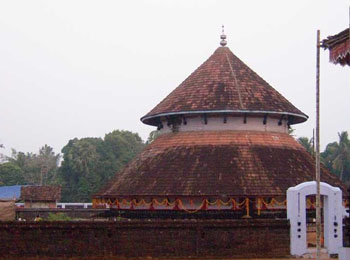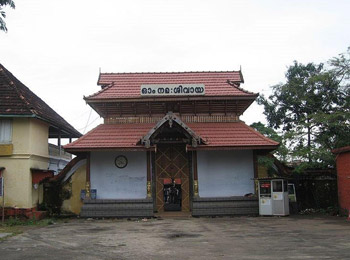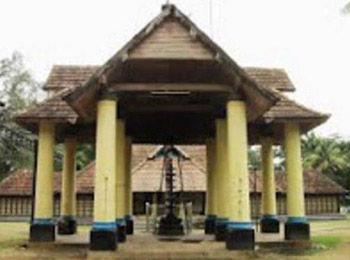- Shiva
Ernakulam Shiva Temple
- Ernakulam,Kerala
- View on map
- Tell us about this temple
Overview
The Ernakulam Shiva Temple is a major temple in Kerala. It is located in the heart of Ernakulam.
About The Temple

The temple is located within the Durbar Hall Ground. The temple history itself has deep association with history of the city and was one of the 7 royal temples of Kochi Maharajas. The temple is now under administration of Cochin Devasom Board. The temple in its current form was built under active patronage of Diwan Sri Edakkunni Sankara Warrier in year 1846 and raised it level of a Royal temple in the Kochi Kingdom. The temple is built on 1-acre (4,000 m2) land. The temple is one of the major Shiva temples in Kerala counted along with the Ettumanoor Mahadevar Temple, Kaduthruthy Mahadeva Temple, Vaikom Temple, Chengannur Mahadeva Temple and Vadakkunathan temple. The entire temple is located in 1.2-acre (4,900 m2) land.[citation needed The temple is built in typical Kerala temple architecture. The Sanctum complex is circular with fine sculpted walls. The roof is covered with copper tiles. The temple has two gates, the western Gopuram is a two storied structure in typical Kerala architecture with gabled roofs and slanting windows. The eastern gopuram is recently renovated similar to the western side. The Devaswom office is located near the western Gopuram. Recently a new marriage hall and Oottupura (dining hall) is constructed at the northern side. Adjacent to the main Shiva Temple, two other temples are constructed in the temple grounds, which makes the Ernakulam Temple Complex. On the Northern side, a Murugan Kovil built in Tamil style can be seen. It was constructed by Tamil residents of Kochi during the administration of Diwan Venkataswamy who was a Tamil Brahmin. The Muruga Kovil is managed by Tamil Brahmin Association of Ernakulam and all rituals in this temple are in accordance to Tamil style. The presiding deity is Lord Muruga with his consorts Valli and Devanyani. There are two separate shrines for Navagrahas and Ganesha, apart from regular poojas for Vishnu, Dakshinamoorthy and Durga Devi.
About The Deity

The presiding deity of the temple is Lord Shiva in Gourisankara form, located in main sanctum sanctorum, facing west towards the Arabian sea. The Lingam in the main sanctum sanctorum is considered to be Swayambhoo (Divinely derived). On the northern side of the main sanctum sanctorum, one can see the small shrine of Kirthamoorthy where the original Lingam worshipped by Arjuna is still worshiped. On the southern side, a small shrine for Lord Ganesha is seen. There is a small area behind the main sanctum sanctorum, considered as abode of Goddess Parvati, hence the east gate is known as the Devi Gate. Outside the Inner temple circle, shrines for Lord Ayyappa and Nagaraja are worshiped. The temple, dedicated to Lord Shiva, is considered as the city temple, with the presiding deity as the protector of the city, as per local Hindu faiths and traditions. As per the common practice in Kerala, the deity is reverently called Ernakulathappan, which means Lord of Ernakulam.
Legend and Stories
Cheranalloor Kartha Family of South Chittor was the founder of Ernakulam Siva Temple.As per the devaprasna this temple have a connection with Vaishnava.Jadavedan nampoothiri was the swamiyar of Ernakulam Siva Temple and Thiruvananthapuram Shri Padmanabhaswamy Temple.He was a member of Cheranalloor Kartha Family of South Chittoor. The temple's legend is deeply associated with Hindu epic Mahabharata. Arjuna, the 3rd Pandava made a severe penance to propitiate Lord Shiva. Pleased with Arjuna’s devotion Shiva accompanied with his consort Sri Parvathi set out from their abode atMount Kailash to meet Arjuna. Shiva intends to impress Parvathi with the devotion Arjuna has towards him. Shiva disguises himself as "Kiratha" a tribal hunter before appearing before Arjuna. The vanquished Arjuna, unable to even stand up makes a Shiva Linga out of mud and performs a pooja offering flowers. To his surprise, he sees that the flower he offers over the Shiva Linga is falling over the head of Kiratha. Arjuna then realises that Kiratha is none other than his Lord Shiva. Pleased with his devotion and sincerity, Lord Shiva granted Pashupatha Arrow to Arjuna. Arjuna left this place and soon this area was covered with dense forest, uninhabited for long time. The existence of the Shiva linga made by Arjuna also disappeared from memories of all. Centuries later, a boy named Devala who has been cursed by a sage, now has a body of a snake, crawled into this forest and saw this lingam completely submerged into mud . He worshiped this lingam as part a deep penance in hope for redeeming from the curse. Soon a few people spotted this mysterious man with body of snake and called him as Rishi Nagam (Saint Serpent) and feared even to come near to him. Some even tried to thwart him with sticks etc. Unmoved by all these action, Rishi Nagam continued his severe penance. Finally Lord Shiva and Parvathi appeared in their original form and asked the sage to take a dip in the nearby pond. As soon as he immersed, he was redeemed from the curse. Soon a new idol appeared just near to the original lingam. Based on this legend, the place got its new name, Rishnagakulam (The pond of Rishi Nagam) and the temple was constructed by the public.
History
The existence of temple was first mentioned in Sangam Literature as one of the major temples under Chera Dynasty. Cheras were adherent worshipers of Lord Shiva. When Chera dynasty ended, the place fell into the hands a few Nair nobles who renamed the place as Ernakulam (corrupt form of original word- Eere Naal Kulam meaning Pond with water always) in recognition of the famous sacred pond of this temple. Soon this area came under reign of Kochi Kingdom. The Kochi Rulers, due to the siege of Fort Kochi by the Dutch in the 17th century, moved their capital to Ernakulam and established a Palace close to this temple, facing the temple pond (The Tank Shed Palace seen behind current Durbar Hall). This helped the temple to gain prominence, due to royal patronage. The temple deity was declared as protector of Ernakulam city (Nagara Devata), which was one of the major reasons of contention between Edappally Nair Lords who were the traditional feudal lord of the town and the Kochi Maharajas.
The second phase of the temple came in 1842 when Diwan of Kochi, Sri Edakkunni Sankara Warrier felt to renovate the temple which was in dilapidated condition. Works were started in 1843. Two new Gopura Mandapams (Entrance Towers) were constructed in traditional Kerala style similar to Sree Poornathrayesa Temple of Tripunithura which was the Chief Royal temple of Kochi Maharajas. The new temple complex was opened to public in 1846. The temple was elevated to a royal temple and brought under direct administration of Kochi Government's Devaswom Board. In 1949, when Kochi acceded into India Union, the Devaswom Board came under new Government's control, which still remains.
Festivals
The Uthsavom (temple festival) of Shiva temple is one of the grandest festivals in the Kochi city, normally celebrated during December–January time. The festivities starts with Kodiyettam (hoisting of the temple flag ) on the first day evening. On the seventh day there is Pakalpooram, when the deity is being taken out in procession with caparisoned elephants with Panchavadyam and finally terminating at Durbar Hall Ground after the famous Pandimelam and colourful fireworks. On the final day around evening, in a solemn ceremony the flag is lowered and the deity is then taken for the Arattu (holy bath) in the nearby temple tank. After that starts the famous Arattu procession with the accompaniment of Panchavadyam. The procession terminates at Durbar Hall Ground. The grand fireworks then bring the curtain down to this week-long festival. During all these days Sheeveli is arranged inside the temple and the best available Chendamelam artists are arranged for this. Special poojas connected with the festival are conducted every day by famous priests from Chennose and Puliyannur Mana. A variety of cultural programmes are also arranged during these days. Special emphasis is given to promote temple arts like Ottamthullal, Paatakam, Thayambaka, Kathakali, Classical dances, Classical music concerts, Bhajans etc. Annadanam is also arranged. Thousands of people throng the temple to witness these programmes. Watching the Pakalpooram and Arattu processions will be an unforgettable experience for anybody. The adjacent Durbar Hall ground becomes a beehive of activities during the Uthsavom.
Poojas Timing
|
S.no |
Pooja Name |
Timing |
|
1. |
Nadathurakal Time |
3.30 AM |
|
2. |
Nirmalyam |
3.30 AM |
|
3. |
Abishekam |
4.00 to 4.45 AM |
|
4. |
Shankhabhishekam |
5.15 AM |
|
5. |
Ushapooja Nadathurakal |
5.45 AM |
|
6. |
Yethertha Pooja Nadathurakal |
6.15 AM |
|
7. |
Ethirtha Sheeveli |
6.30 AM |
|
8. |
Pantheeradi Pooja |
7.30 to 8.15 AM |
|
9. |
Uchcha Pooja |
9.30 to 11AM |
|
10. |
Vykunneram Nadathruakal |
4.00 PM |
|
11. |
Deeparadhana |
6.45 PM |
|
12. |
Athaazhapooja Nadathurakal |
7.30 PM |
|
13. |
Thripuka Nadathurakal |
8.00 PM |
Accessibility
The Cochin International Airport is well connected to major cities all across India and the world. From the airport, the main city centre is about 29 kilometres away. Buses, taxis, cabs, and trains can be used for the purpose of reaching the requisite destination from the airport. Cochin is well connected to all the major railway stations in India. Most of the Kerala bound trains have a stop at either of the two railway stations in Cochin – Ernakulam Town Station and Ernakulam Junction Station. From the railway station, one can board a bus, a taxi or a cab to reach the required destination in Cochin. Cochin has a strong network of Kerala State Run Transport Corporation (KSRTC) bus services that connects it to all the major cities in Kerala and with some of the major cities in Tamil Nadu and Karnataka. Air-conditioned deluxe Volvo bus services are available from Cochin to cities such as Hyderabad, Mumbai, Chennai, Bangalore and Trivandrum.
Temple Address
Ernakulam Shiva Temple,
Ernakulam,
Kerala.
Significance
Devotees visit this temple to seek fulfillment of the following:-
- For relief from sufferings
- To attain salvation
Shlokas
Aum Trayambakam Yajaamahey Sugandhim Pusti Vardhanam Urvaarukamiva Bandhanaath Mrutyor Muksheeya Maamritaat
Meaning -We worship the fragrant Lord Shiva, who has 3 eyes and who cultivates all beings. May He free me from death, for immortality, as even a cucumber is separated from its bond with the vine.
Kailaasarana Shiva Chandramouli Phaneendra Maathaa Mukutee Zalaalee Kaarunya Sindhu Bhava Dukha Haaree Thujaveena Shambho Maja Kona Taaree
Meaning -Oh Lord Shiva who is seated on Mount Kailash, where the moon decorates his forehead and the king of serpents crown his head, who is merciful and removes delusion, You alone can protect me. I surrender to thee.
Timings
Morning 6 AM to Evening 9 PM.
